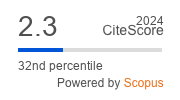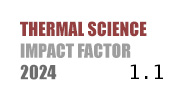THERMAL SCIENCE
International Scientific Journal
STUDY ON MECHANICAL BEHAVIOR AND MICROSCOPIC FAILURE CHARACTERISTICS OF DEEP ROCKS CONSIDERING THE INFLUENCE OF INTERNAL STRESS
ABSTRACT
To address the limitation of traditional discrete element modelling in considering internal stress, this study proposes a new numerical simulation process based on particle flow code in 2-D, which successfully achieves internal stress consolidation-sealing. Triaxial compression tests were conducted to analyze the impact of internal stress evolution on rock mechanical properties. Under a confining pressure of 10-20 MPa, internal stress causes the peak stress of the rock to be higher than when there is no internal stress, while the opposite is true at 30-40 MPa. The elastic modulus is consistently higher in rocks with internal stress. The trend of increasing the number of rock cracks with and without internal stress is similar, and the growth rate of tensile cracks is higher than that of shear cracks. Internal stress promotes crack propagation. The axial development of cracks is more pronounced. This study offers new insights into in-situ rock mechanics.
KEYWORDS
PAPER SUBMITTED: 2024-08-15
PAPER REVISED: 2024-11-03
PAPER ACCEPTED: 2024-11-22
PUBLISHED ONLINE: 2025-06-01
THERMAL SCIENCE YEAR
2025, VOLUME
29, ISSUE
Issue 2, PAGES [1295 - 1300]
- Ran, Q. C., et al., Deterioration Mechanisms of Coal Mechanical Properties under Uniaxial Multi-Level Cyclic Loading Considering Initial Damage Effects, International Journal of Rock Mechanics and Mining Sciences, 186 (2025), ID106006
- Ran, Q. C., et al., Hardening-Damage Evolutionary Mechanism of Sandstone under Multi-Level Cyclic Loading, Engineering Fracture Mechanics, 307 (2024), ID110291
- Gao, M.Z., et al., The Mechanism of Microwave Rock Breaking and Its Potential Application Rock-Breaking Technology in Drilling, Petroleum Science, 19 (2022), 3, pp. 1110-1124
- Li, F., et al., Study of Damage Constitutive Model of Brittle Rocks Considering Stress Dropping Characteristics, Advances in Civil Engineering, 2020 (2020), ID8875029
- Li, F., et al., Research on Physical-Mechanical Properties and Energy Evolution Characteristics of Granite after High Temperature Treatment, Thermal Science, 27 (2023), 1B, pp. 497-504
- Gao, M. Z., et al., Fractal Evolution and Connectivity Characteristics of Mining-Induced Crack Networks in Coal Masses at Different Depths, Geomechanics and Geophysics for Geo-Energy and Geo-Resources, 7 (2021), 1, ID9
- Gao, M. Z., et al., Discing Behavior and Mechanism of Cores Extracted from Songke-2 Well at Depths Below 4,500 m, International Journal of Rock Mechanics and Mining Sciences, 149 (2022), ID104976
- You, S., et al., Experimental Study on Hydraulic Failure Mechanism and Energy Storage Characteristics of Deep Granite (in Chinese), Journal of Central South University (Science and Technology), 52 (2021), 8, pp. 2839-2848
- Wang, T., et al., Residual Stress Measurement and Analysis of Siliceous Slate-Containing Quartz Veins, International Journal of Minerals Metallurgy and Materials, 30 (2023), 12, pp. 2310-2320
- Chen, W. C., et al., A Novel Design for Storage of Inner Stress by Colloidal Processing on Rock-Like Materials, Journal of Geophysics and Engineering, 15 (2018), 3, pp. 1023-1031
- Cundall, P. A., Strack, O. D. L., Discrete Numerical-Model for Granular Assemblies, Geotechnique, 29 (1979), 1, pp. 47-65
- Wang, D. M., et al., Discrete Element Analysis on the Influence of Drilling Fluid Pressure on Core Discing in Pressure-Preserved Coring, Thermal Science, 27 (2023), 1B, pp. 655-662
- Sinha, S., et al., Effect of Damping Mode in Laboratory and Field-Scale Universal Distinct Element Code (UDEC) Models, Rock Mechanics and Rock Engineering, 55 (2022), 5, pp. 2899-2915
- Jimenez-Herrera, N., et al., Comparison of Breakage Models in DEM in Simulating Impact on Particle Beds, Advanced Powder Technology, 29 (2018), 3, pp. 692-706
- Yang, M. Q., et al., Experimental Study on Non-linear Mechanical Behavior and Sampling Damage Characteristics of Rocks from Depths of 4900-6830 m in Well Songke-2, Journal of Central South University, 30 (2023), 4, pp. 1296-1310
- Li, F., et al., Formation Mechanism of Core Discing During Drilling under Deep In-Situ Stress Environment: Numerical Simulation and Laboratory Testing, Journal of Central South University, 30 (2023), 10, pp. 3303-3321
- Potyondy, D. O., Cundall P. A., A Bonded-Particle Model for Rock, International Journal of Rock Mechanics and Mining Sciences, 41 (2004), 8, pp. 1329-1364
- Gao, Y. N., et al., The Acoustic Emission Behavior and Its Fractal Characteristics of the Sandstone under the Disturbance Stress Paths, Rock Mechanics and Rock Engineering, 56 (2023), 8, pp. 5487-5511
- Gao, M. Z., et al., Mechanical Behaviors of Segments in Small Curvature Radius Intervals of Shield Tunnels: From Field Monitoring to Laboratory Testing, Rock Mechanics and Rock Engineering, 56 (2023), 11, pp. 8115-8134
- Gao, M. Z., et al., Mechanical Behavior of Coal under Different Mining Rates: A Case Study from Laboratory Experiments to Field Testing, International Journal of Mining Science and Technology, 31 (2021), 5, pp. 825-841
- Gao, Y. N., et al., Does Double Pre-Notches Have a Greater Impact than Single Pre-Notch on the Mechanical and Fracture Behavior of Rock? Insights from Three-Point bending Tests Using the Numerical Approach of Grain-Based Model, Theoretical and Applied Fracture Mechanics, 133 (2024), ID104624

